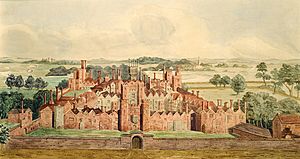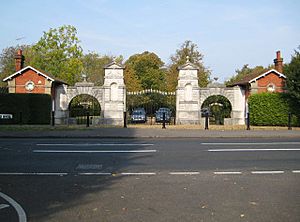Oatlands Palace facts for kids
Oatlands Palace was a grand royal palace from the time of the Tudor and Stuart kings and queens. It was built in a village called Oatlands, near Weybridge, in Surrey, England. Not much of the original palace is left today. In 1964, people dug up the area to find out more about how big it used to be.
A Royal Palace is Built
Much of the stone used to build the palace came from Chertsey Abbey. This abbey became a ruin after King Henry VIII closed many monasteries during the Dissolution of the Monasteries.
King Henry VIII bought the house in 1538. He then rebuilt it to be a palace for his new wife, Anne of Cleves. The palace was very large, covering about 14 hectares (which is like 28 football fields!). It had three main courtyards and used an older house that was already there. Henry VIII married Catherine Howard at this palace on July 28, 1540. His next wife, Catherine Parr, also spent time at Oatlands. She even sent a letter from the palace in July 1543, shortly after marrying the King.

Oatlands Palace later became a home for other famous royals. These included Queen Mary I, Queen Elizabeth I, King James I, and King Charles I.
Queen Mary I went to Oatlands after people thought she was pregnant. Her staff for the baby had been at Hampton Court Palace. Moving to Oatlands, which was much smaller, showed that her pregnancy was not going to have a happy ending.
In August 1603, Prince Henry and Princess Elizabeth lived at the palace. Prince Charles moved there in September 1604. King James I visited in 1605 and enjoyed fishing in the River Thames. The palace was a bit old and leaky, with rain getting into the royal rooms.
King James I's wife, Anne of Denmark, added a special house for silkworms and a vineyard. She also hired a famous architect named Inigo Jones to design a beautiful gate for the gardens. Her art collection at Oatlands included paintings of her family and friends. One painting by Paul van Somer showed her with her horse, hunting dogs, and an African servant, with the new gateway and palace in the background.
Important visitors came to see Anne of Denmark at Oatlands. For example, the ambassador from Savoy visited in October 1614. She also held a big party for the Venetian ambassador in August 1618. They had a grand dinner, and even though a planned hunt was rained out, they still had a good time.
Oatlands was given to Henrietta Maria when she married Charles I. She used it as a quiet country home and kept some of her art collection there. She also hired John Tradescant the elder to work on the gardens.
In 1646, Princess Henrietta of England, who was King Charles I's baby daughter, stayed at Oatlands. Her governess helped her escape to France that summer. After King Charles I was executed, the government sold some royal homes to pay its debts. Oatlands Palace was bought for about £4,000 by Robert Turbridge. He tore it down and sold the bricks to Sir Richard Weston. A single house, which might have been a hunting lodge, is the only part that remained.
A New House on the Estate
After the King was restored to power in the 1660s, a new house on the Oatlands estate became the home of William Boteler. He had supported the Commonwealth government.
Later, Sir Edward Herbert, a chief judge, lived in and made the house bigger. But he lost it when he followed King James II into exile. The house was then given to his brother, Arthur Herbert, 1st Earl of Torrington, who was a famous admiral.
The Duke of Newcastle, Henry Clinton, made the house even bigger and created beautiful formal gardens.
In 1790, Prince Frederick, Duke of York and Albany, who was the second son of King George III, leased Oatlands. He is the "Grand Old Duke of York" from the nursery rhyme! His architect was Henry Holland.
The famous composer Joseph Haydn visited Oatlands in November 1791. He wrote about it:
The little castle, 18 miles from London, lies on a slope and commands the most glorious view. Among its many beauties is a most remarkable grotto which cost £25 000 sterling, and which was 11 years in the building. It is very large and contains many diversions, inter alia actual water that flows in from various sides, a beautiful English garden, various entrances and exits, besides a most charming bath.
Haydn was a guest of the Prince of Wales and the Duke of York. He played music for them for four hours every evening.
Mansion Becomes a Hotel
In 1794, the mansion burned down. It was quickly rebuilt in a popular style called Gothic. After the Duchess of York died in 1820, the whole property was sold. Edward Hughes Ball Hughes bought it in 1824 and changed it again in 1830.
The arrival of the London and South Western Railway in 1838 made it easier for people to travel to London every day. In 1846, the estate was divided into smaller pieces and sold for building new homes. After being owned by James Watts Peppercorne for a while, the house became a hotel in 1856. It was first called the South Western Hotel and later the Oatlands Park Hotel.
During World War I, from 1916 to 1918, the hotel was used as a hospital for New Zealand soldiers who were hurt in France. Because of this, one of the main streets in Walton-on-Thames was renamed New Zealand Avenue to honor them.
Today, the four-star Oatlands Park Hotel stands where the Oatlands mansion used to be. You can still see some parts of the older buildings within the hotel. It's important to remember that this hotel is not on the exact spot of the original Oatlands Palace. The palace was further down the hill, closer to the center of Weybridge, but it was all part of the same large estate back then.
Images for kids





